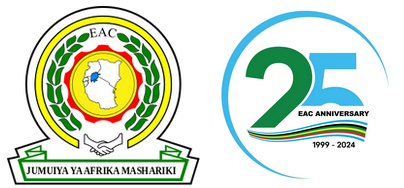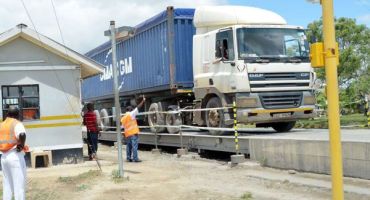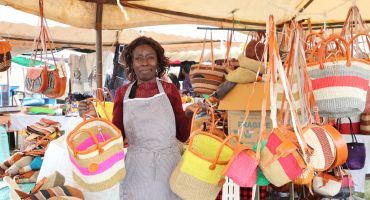Collection, Analysis , Compilation and dissemination of trade and Investment information
Trade Information Portals
As a means of facilitating trade and increasing transparency, EAC developed and launched a Trade Information Portal (TIP). The TIP gives access to step-by-step guides on licenses, pre-clearance permits and clearance formalities for the most traded goods within, to and from the EAC.
The TIP is linked with national trade portals that present step-by-step the national import and export procedures in Burundi, Kenya, Rwanda, Tanzania and Uganda.
For each step, the trade portal tells the user where to go, who to see, what documents to bring, what forms to fill, what costs to pay, what law justifies the step, and where to lodge a complaint in case of a problem.
A central part of the TIP is the Trade Facilitation Index (TFI), which enables institutions engaged in trade facilitation to measure and compare the ease of importing and exporting, and the related administrative burden between EAC Partner States. The EAC trade information portal and trade information portals (TIPs) in Partner States are accessible at: tradehelpdesk.eac.int
EAC Trade and Investment Report
The EAC Secretariat annually compiles, publishes and disseminates trade information through the production of the Annual EAC Trade and Investment Report.
EAC Trade and Investment Report 2023 - Highlights
With an estimated population of 305.3 million people, the EAC region offers a large market, with immense potential for trade in goods and services produced within the region and from the globe. The region is endowed with an abundance of most precious natural resources ranging from minerals, oil and gas, fish, arable land, beautiful climate and tourist attractions, quality human capital and the region’s strategic location in the world, makes it an ideal destination for foreign investment. Most recently, the region has improved its infrastructure, such as roads, ports, airlines, electricity, and telecommunication, and enjoys good governance of the Partner States, which creates a conducive environment for both local and foreign investors.
EAC Partner States have been committed to a smooth flow of goods and services by removing barriers to trade and investment and have implemented a wide range of enhanced technology trade facilitation instruments to ease cargo movement and increase intra and extra trade, and to attract local and foreign investments to boost economic productivity and create jobs. Deeper integration through the TFTA and AfCFTA market access creates further trade opportunities for the region.
EAC developments in economic, trade and investment
The East African region has experienced the spillover effects of these global crises resulting in supply shortages of essential commodities, fuels and fertilizers, leading to increased cost-of-living with rising prices for energy and food which reduce real incomes and aggravate debt stress.
Despite these challenges, the EAC economy grew by 5.1% in 2023, with most macroeconomic indicators remaining stable and resilient. This economic growth trajectory is projected to be sustained driven by expected strong performance in agriculture and services sectors. Notably the region’s economic growth did not carry with it much needed structural adjustments critical for resilient growth and development. Across the Partner States current account deficits deteriorated due to higher import bills and world market prices, while fiscal deficits recorded mixed trends reflecting the persistent low domestic resource mobilisation, increased spending coupled with tight global financial conditions. The outlook for the external sector remains uncertain owing to uncertainties in the global landscape.
Merchandise trade
EAC Trade in goods and services continued a steady growth path in 2023 and is projected to rise further driven by accelerated trade, economic integration and transformation globally and regionally. While EAC exports are still primarily agriculturally based low-technology commodities, the share of manufactured goods in total exports especially to regional markets has been increasing gradually supporting the regions post pandemic recovery.
In 2023, total global merchandise trade by the EAC grew by 2.37%, valued at more than US$80 billion. Intra-EAC total trade similarly grew by 13.1% to US$12.1 billion in 2023, with the percentage share of intra-EAC trade to EAC total trade increasing to 15%. The European Union and Asia were the major destinations for agricultural and primary products exports, with regional markets key destinations for manufactures. Key manufactured exports included textiles, chemicals, edible oil, cement, iron and steel, cosmetics and pharmaceuticals. Partner States remained net importers of commodities including petroleum products, industrial machinery, textiles, crude palm oil, motor vehicles, cereals, rice, transport equipment, fertilisers, chemicals and raw materials for industrial production. China remined the dominant source of EAC imports valued at US$11 billion, followed by the United Arab Emirates (UAE) with imports valued at US$6.4 billion in 2023.
Continental trade through the AfCFTA has emerged as potential driver for increased trade by the EAC, with intra-African trade expanding supported by lowering of trade barriers, enhanced infrastructure, and development of regional value chains. The Regional Economic Communities (RECs)’ continue to be the major export destinations for EAC exports with COMESA registering US$6.6 billion and SADC US$4.1 billion in 2023. China is the dominant source of EAC imports with a value of US$11 billion, followed by the United Arab Emirates (UAE) at US$6.4 billion in 2023. There is a need for substantial transformation in the industrial and agricultural sectors for EAC to benefit from regional integration to allow key products with export potential to enter the global value chain supply systems.
Trade in services
Global trade in services remains vibrant, with travel and transport accounting for the highest contribution in both Africa and EAC. Services play a critical role in enhancing the diversity and quality of manufactured goods and in facilitating this process at the regional level. Export of services in the EAC during the year 2023 grew marginally at 1.7%. Total trade services remained the key diver of the Partner State economies accounting for over 40% of the respective country GDPs. In 2023 country specific services grew by 12.51% in Burundi, 13.24% in Rwanda, 32% in Tanzania declines by 12.75% in Kenya, 1.07% in South Sudan and 7.8% in DRC. Both service imports and exports were concentrated in transport, tourism.
Investment
As a result of the many challenges in the global business environment and the muted demand occasioned by high costs of living, Foreign Direct Investment maintained a slowdown during 2023, occasioned by global financial volatilities and geopolitical tensions, with Africa and the developing economies being hardest hit. However, the EAC region registered growth in both domestic and foreign investment, with most investment directed to communications, ICT services and software and consumer products, biotechnology. The major sources of FDI flows into Africa include USA, UAE, France and India. In 2022, the United States invested US$7 billion in Africa, the most since 2018, with South Africa, Egypt, and Kenya receiving the most funds. There was substantial cross border investment, a sign of confidence in the EAC regional integration agenda. With the increase in FDI across most of the Partner States, there has been an increase in the number of jobs created through the EAC FDI such as the Republic of Burundi and the Republic of Kenya. Even for Partner States that had a decrease in FDIs, recorded an increase in jobs created through domestic and cross border investments.
Regional Outlook
According to AfDB, the Eastern Africa Region is expected to maintain its position as Africa’s fastest growing region, with real GDP growth rising from an estimated 1.5 percent in 2023 to 4.9 percent in 2024 and 5.7 percent in 2025. For the region’s economies the forecast growth acceleration in 2024 will be bolstered strong government spending and strategic investments to improve in-country connectivity and facilitate trade with neighbouring nations, coupled with ongoing efforts to modernize agricultural production and boost productivity in the services sector.
The EAC region’s economies economic recovery is expected to strengthen considering the global economic resilience, continued fiscal consolidation measures, declining inflation, and progress on debt restructuring. However, an increasingly complex interplay between economic, climate and geopolitical risks could affect the economic performance and recovery of the EAC. The main risks being high inflation, widening fiscal deficits, rising commodity prices, stalled trade and investment fuelled by rising geopolitical tensions and regional conflicts and climate shocks.
Despite the potential negative impact of these risks, the recent progressive trend of improving global market conditions, fiscal consolidation, debt restructuring, renewed investment and capital accumulation are encouraging. Combined these have the potential to stimulate investor confidence in the EAC, driving the pace of structural transformation and strengthening economic growth across the EAC.
Looking Ahead
Looking ahead, as the EAC continues to chart its path to economic recovery and sustainable growth, a mixture of policies is needed to address macroeconomic challenges and put Partner State economies on course towards achieving structural transformation.
Trade and investment driven development requires a conducive environment fundamentally dependant on robust demand, strengthened productive capacities, high integration with global and regional value chains, and strong inter and intra-regional trade. Therefore, policy coordination focusing on long-term sustainability while mitigating short-term risks is crucial for accelerating the economic growth of the EAC and transforming the region into an important global trading partner and ideal investment destination.



